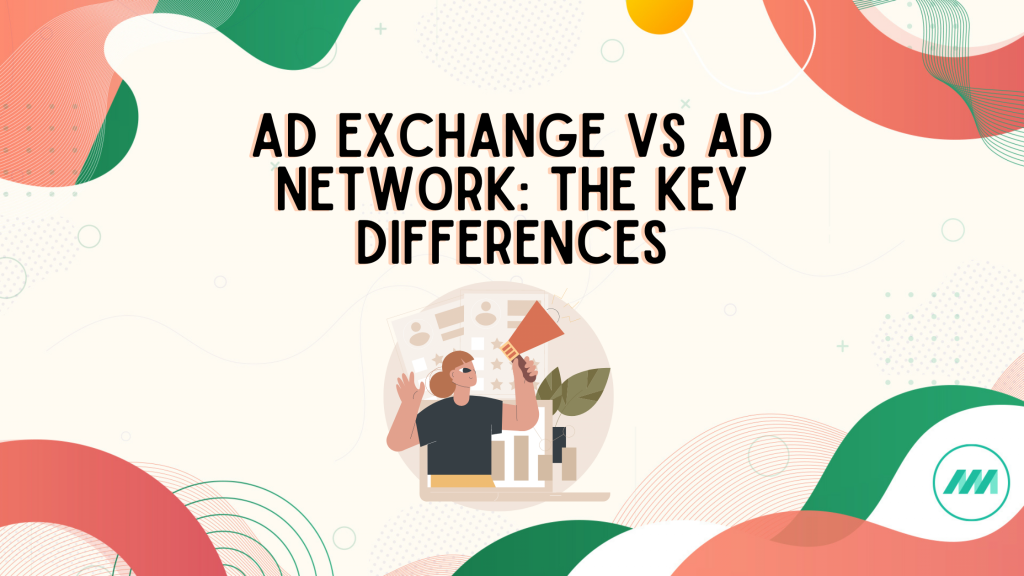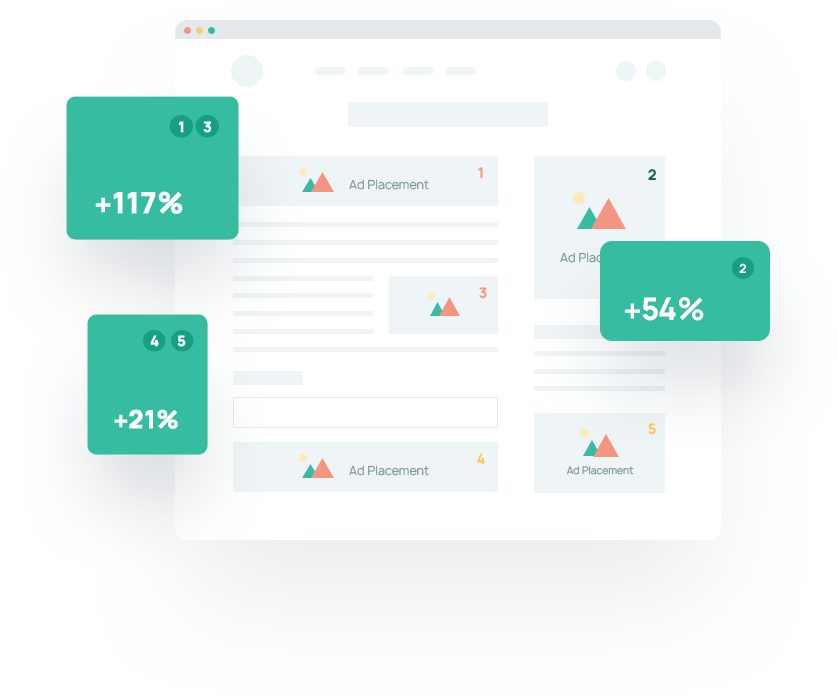The terminology and processes can get a little confusing when it comes to digital marketing and digital advertising. You have ad exchanges, ad networks, demand-side platforms (DSPs), supply-side platforms (SSPs), and more.
If that’s not enough, remember that a robust programmatic ecosystem has evolved to create a digital marketplace for programmatic advertising.
All of these things work separately and together to help advertisers and publishers facilitate buying and selling online ads. In this article, we will explain the differences between ad networks vs. ad exchanges, DSPs vs. SSPs, how each works, and how they all work together.
What is an Ad Exchange?
An ad exchange is an online marketplace that allows advertisers to buy and publishers to sell ad inventory.
Publishers sell ad inventory through ad exchanges, which facilitate the buys. Advertisers can buy across multiple sites at once. This avoids having to negotiate individually with each website. By offering a huge pool of ad impressions, advertisers choose which impressions they want to purchase.
Advertisers are competing against other advertisers and ad networks in real-time auctions. Advertisers will typically use demand-side platforms (DSPs) to create audience targeting and bid goals to try to buy relevant impressions at the lowest possible price.
DSPs interact with a supply-side platform (SSP) which lets publishers offer ads to the ad exchange.
Some of the largest ad exchanges include:
- Google AdX (Previously known as DoubleClick Ad Exchange)
- OpenX
- Xandr (Previously known as AppNexus)
- Verizon Media
- Magnite (Previously known as the Rubicon Project)
- PubMatic
There are two types of ad exchanges, open and private, with key differences between the two.
Open Ad Exchanges
In programmatic ad buying, an open exchange allows any qualified advertiser or publisher to participate. Publishers make their ad inventory impressions available at the minimum cost per thousand (CPM) pricing they are willing to accept. Advertisers bid against each other in real-time, with the highest bidder getting the impressions.
Private Ad Exchanges
In private ad exchanges, the bidding process works the same way, but publishers can restrict who participates. Advertisers that are invited to bid get priority in bidding on ad inventory before it hits the open market. The highest bidder wins the auction. Typically, if there are impressions that go unsold or advertisers are not willing to meet publisher minimums, it is then offered into the open ad exchange.
What is an Ad Network?
An ad network is an intermediary to broker deals between advertisers and publishers. Ad networks aggregate publisher’s inventory from multiple sources and match it to advertiser requests, such as particular audience segments, demographics, behavioral characteristics, or context. Advertisers can also set campaign parameters, such as budget and frequency caps.
Publishers install code snippets that contain the ad network tags on their website, which produces an ad call each time a user visits a web page. When an ad call occurs, the ad network finds a match in real-time to deliver the ad,
Ad networks can sort ad inventory to ensure advertisers get the best-fit audience for their ad buying, and publishers get the highest-paying rates.
Some of the more popular ad networks include:
- Google AdSense
- Amazon Publisher Services
- Newor Media
- Propeller Ads
- Revcontent
- Ezoic
- AdRoll
- Microsoft Ad Network
Technically, Newor Media is a full-service ad management solution and header bidding provider (that’s an advanced programmatic technique that generates higher bid rates). However, we also function as an ad network for publishers.
For publishers, ad networks eliminate the cost of having to sell inventory directly to advertisers. Ad networks can also supplement existing ad sales. Since ad networks have access to thousands of advertisers that publishers do not have relationships with, these ad networks can dramatically increase fill rates and produce ad revenue that might otherwise go unsold.
There are different kinds of ad networks as well, including:
- Premium ad networks that offer inventory from premium publishers.
- Vertical ad networks that tend to focus on specific topics or industries
- Specialized ad networks that provide a specific type of ad units, such as mobile or video.
- Affiliate ad networks that offer inventory on a revenue share cost per click (CPC) or cost per acquisition (CPA) model.
Traditional ad networks offer advertisers a group of impressions on a cost-per-thousand impressions (CPM) basis, which may extend across multiple publishers.
Key Differences Between Ad Networks and Ad Exchanges
There are key differences between an ad network and an ad exchange. Publishers need to know how both operate and the nuance of each from how they handle ad buying, available inventory, and the costs involved.
| Ad Network | Ad Exchange | |
| Functions | Works as an intermediary between publishers and advertisers. | Works as either an open marketplace for publishers and advertisers or a private marketplace for specific publishers and advertisers. |
| Models | A company that facilitates ad buying and selling. | An AdTech platform that facilities ad buying and selling. |
| Users | Advertisers, agencies, and publishers. | Advertisers, agencies, publishers, ad networks, and other ad exchanges. DSPs, and SSPs. |
| Offers | Offers categories of segmented ads to match advertiser audience targets. | Provides an open pool of ad inventory. |
| Quality | Provides mostly premium inventory for first looks. | Provides all available inventory, including remnant or ad space that wasn’t sold in ad networks. |
| Transparency | Neither advertisers nor publishers will know who is buying or selling the inventory, although there are controls to protect brand safety. | Advertisers and publishers can know who is buying and selling inventory. In some exchanges, advertisers may have access to competitive bids. |
| Pricing | Costs are set by the platform for handling transactions, so prices are stable and known. Revenue for publishers can still vary based on supply and demand. | Inventory costs fluctuate greatly based on supply and demand during a real-time bidding process, so revenue for publishers can also vary greatly. |
What is a DSP (Demand-Side Platform)?
A demand-side platform (DSP) is a programmatic advertising platform that lets advertisers and agencies bid on available ad inventories from different publishers. DSPs automate much of the buying process for advertisers to buy display, banner, video, search, mobile, and other types of ads.
Rather than having to involve staff members to handle insertion orders (IOs), DSPs use algorithms to negotiate ad rates and provide the IO details. Instead of making a specific buy on a specific publisher’s website, marketers can target audiences based on demographic, geographic, behavioral, or contextual criteria and buy impressions across a range of publishers.
DSPs provide real-time bidding (RTB), typically across multiple ad exchanges, to provide greater reach. DSPs can evaluate ad space on supply-side platforms (SSPs) as they appear, including premium inventory and remnant inventory. A match is made when a DSP identifies ad inventories that match user targeting options.
Unlike Google Ads, a DSP has access to a broader assortment of options for advertisers. Google Ads, formerly known as Google AdWords, sells only its own inventory, while DSPs handle ads across various providers.
Notable DSPs include:
- Criteo
- Google Display and Video 360 (DV360)
- Facebook Ads Manager
- Adobe Advertising Cloud
- The Trade Desk
These top five DSPs account for 63% of the global ad market.
For publishers, DSPs can play an important role in helping with fill rates and making sure inventory does not go unsold.
What is an SSP (Supply-Side Platform)?
A supply-side platform (SSP) is a type of ad tech that coordinates the supply of ad inventories from publishers. SSPs help website owners sell ad space and generate ad revenue from their ad units.
SSPs are the publisher equivalent of a demand-side platform and are used to sell display ads, banner ads, video ads, mobile ads, and more on publisher digital properties.
While a DSP allows advertisers to shop around for the lowest prices to fulfill their orders, an SSP is designed to maximize the price of impressions for publishers.
Major SSPs in the marketplace include:
- Google Ad Manager / AdX
- Amazon Ad Services
- PubMatic
- Magnite
- AdMob
- AppLovin (Previously known as MoPub)
You’ll notice some of the same names on several lists because companies offer multiple options.
SSPs sell the ad space to DSPs in automated auctions using an ad exchange. One advantage to publishers is that SSPs sell individual impressions. This provides more control and transparency into who is buying their inventory for optimization.
SSPs also allow publishers to determine what inventory they want to make and limit the ad networks considered for ad placements.
Working together with DSPs, ad exchanges, and ad exchanges, SSPs offer inventory to a wide variety of advertisers using real-time bidding (RTB) or header bidding to achieve a maximum CPM.
Conclusion
Due to the sheer volume of ads being bought and sold, it’s no longer realistic to handle all of them on an individual basis. The ecosystem is simply too large, and manual transactions would leave a lot of ads unsold and a lot of ad revenue on the table for publishers. The advertising industry has come to rely on programmatic advertising methods to buy and sell ads across ad exchanges and ad networks. Real-time bidding and ad serving happen in milliseconds with algorithms matching available ads to available ad inventory and facilitating the buys automatically.
Each publisher will have to make decisions about how to structure their ad sales and which types of technology they want to use for their advertising network. In trying to figure out whether ad exchanges or ad networks are better, advertising industry execs will need to evaluate their options. In most cases, ad networks offer the biggest opportunity for higher rates across a broad group of advertisers.
Because ad networks are easy to use, they can also make sure nearly all of your unsold inventory can turn into revenue. Want to know how much your website could be making? Try our website earnings calculator! Or, if you’d like to keep learning about how all of this works, chat with our programmatic advertising experts today.

